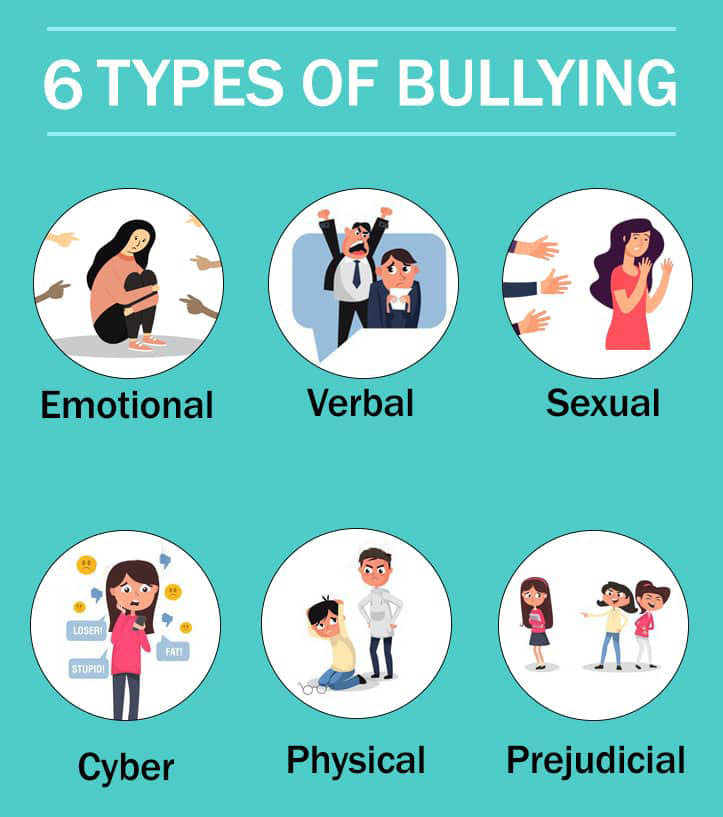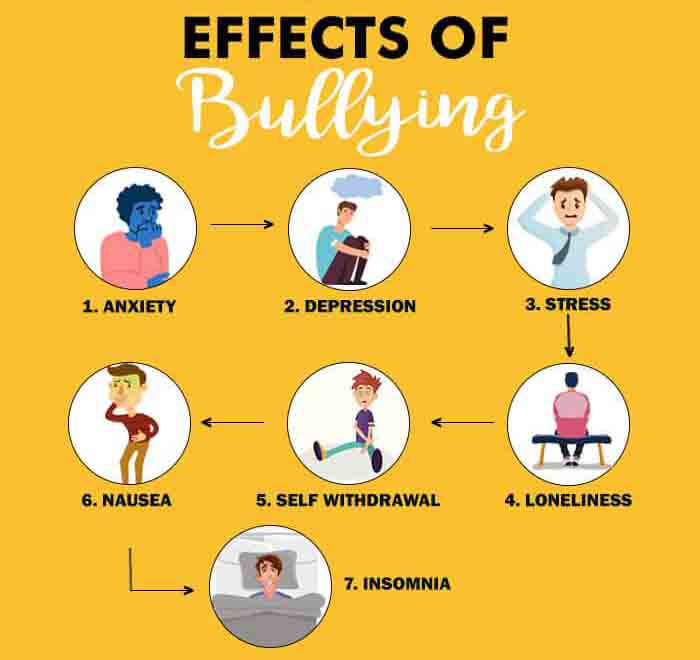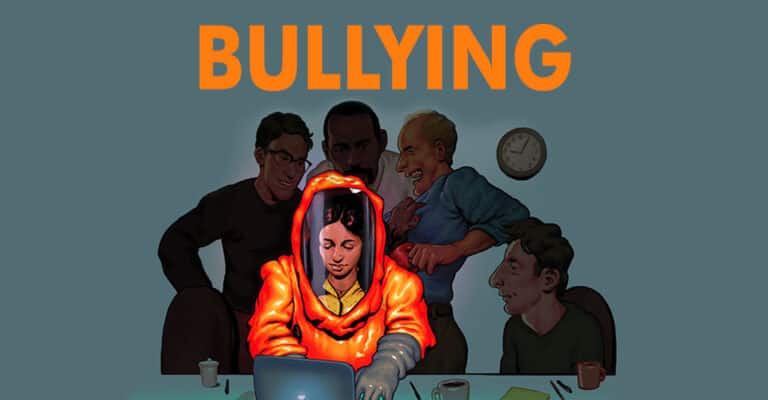Bullying is a type of aggressive behavior where someone repeatedly and intentionally causes discomfort or injury to another person. A person may use force, threat, coercion or even hurtful teasing to aggressively dominate, abuse or intimidate that person.
What Is Bullying?
Bullying is the intention to cause harm or distress in an individual by physically or verbally abusing them. A 2015 study [mfn] Wolke, D., & Lereya, S. T. (2015). Long-term effects of bullying. Archives of disease in childhood, 100(9), 879–885. https://doi.org/10.1136/archdischild-2014-306667 [/mfn] defines it as the “systematic abuse of power and is defined as aggressive behaviour or intentional harm-doing by peers”. This can occur repeatedly and usually involves an imbalance of power between the person getting bullied and the bully. Bullying is more prevalent than what is commonly thought.
A study [mfn] Waseem M, Nickerson AB. Bullying. [Updated 2021 Feb 10]. In: StatPearls [Internet]. Treasure Island (FL): StatPearls Publishing; 2021 Jan-. Available from: https://www.ncbi.nlm.nih.gov/books/NBK441930/ [/mfn] reported that every one out of 5 students reported being bullied in school. Also, most people tend to associate it as a behavior most commonly seen in schoolchildren. However, it can take place in the lives of adults too. It occurs when someone, a person or a child, gets picked on repeatedly by another person or a group. There is often an imbalance of power between the two parties as perceived by the person(s) bullying the individual.
A 2015 study [mfn] Wolke, D., & Lereya, S. T. (2015). Long-term effects of bullying. Archives of disease in childhoo, 100(9), 879–885. https://doi.org/10.1136/archdischild-2014-306667 [/mfn] defines bullying as “the systematic abuse of power and is defined as aggressive behaviour or intentional harm-doing by peers that is carried out repeatedly and involves an imbalance of power.” The study explains that it can have several risk factors associated with it which affects both our physical and mental health.
It is a common practice in our society for individuals to get bullied at their school, work or other social settings. The aggressive behavior exhibited by the person, who is usually a peer of the person getting bullied, is intentional. The bully believes that he or she is on a higher pedestal of power as opposed to the person getting bullied. The bullied person finds it difficult to come out of situations like these and often tends to suffer in silence.
Types Of Bullying

Simply pushing or verbally abusing a person does not fully comprise the different types of bullying that is prevalent in our society. It seems that it can take different forms as shown in a 2011 study [mfn] Vieno, A., Gini, G., & Santinello, M. (2011). Different forms of bullying and their association to smoking and drinking behavior in Italian adolescents. The Journal of school health, 81(7), 393–399. https://doi.org/10.1111/j.1746-1561.2011.00607.x [/mfn]. It is important to note here that different types of it are often intertwined with one another. One type of it can act as a trigger to the other types of bullying. The study mentioned that getting bullied can be in these different forms:
1. Physical Bullying
This is one of the most prevalent and obvious forms of bullying. This takes place when a person uses their physical strength or actions in order to control someone else. Individuals who engage in physical bullying are often bigger and stronger than the person getting bullied. They use this to their advantage, knowing very well that their power and strength can be intimidating to the other person. Getting bullied physically can cause physical injuries as well as damage to property. Some types of physical bullying are:
- Punching
- Shoving
- Hitting
- Kicking
- Slamming
- Slapping
Physical bullying differs from other forms of it as it tends to manifest itself in the form of visible abrasions and wounds.
2. Emotional Bullying
This type of being bullied can present no visible physical symptoms, but can have serious long term effects on the emotional and mental health of a person. It takes place when a person tries to ostracize their peers by altering their social standing and establishing themselves as more popular, powerful and resourceful than the other person. This causes the person getting bullied to feel left out or being unable to identify themselves as part of a social circle. It is a kind of calculated social manipulation where the victim feels alone and isolated. Some types of emotional bullying are:
- Spreading lies and rumors about the victim
- Sharing and exposing embarrassing secrets about the victim
- Manipulating social settings
The victim in situations like these often feels left out or ostracized from society. They feel insulted, ignored, teased, ridiculed or ganged up in their society.
3. Verbal Bullying
This type of bullying involves language, words and painful statements which are intended to make the victim feel insulted, threatened or ashamed. The bully uses certain words or phrases which would be sure to hurt the person mentally and emotionally. They may use slang, abuse or even insult or ridicule the victim. Most of the victims here are weak and cannot defend themselves from verbal bullying. They are either too afraid of the person who might have more social authority or power than them. Most types of it take place in schools, colleges and even professional work environments. Some types of verbal bullying are:
- Name calling
- Teasing
- Using slangs and abusive words
- Spreading rumors
- Teasing
- Making genderist or racist remarks
Victims of it usually have no physical signs of it and thus often face difficulties talking about it to someone. Most bullies use physical and verbal bullying together in order to inflict harm and a sense of shame in the victim.
4. Sexual Bullying
This type can take forms where the person is physically harmed in a sexual manner or even emotional or verbal attacks on a person intended to shame or humiliate them sexually. This type of aggression can change to sexual assault in a short time, where the bully feels the victim is unbale to defend himself/herself. Sexual bullying is often targeted towards women. However, it can occur between the same sexes also. It is not uncommon for women to humiliate other women sexually in manners which insinuates their promiscuity or labels them offensively. Some types of sexual bullying are:
- Unwanted physical touch
- Obscene gestures
- Uninvited exposure
- Abusive sexual comments
Victims of sexual bullying have high chances of being sexually assaulted or even raped. They are often unable to approach anyone about their problems due to fear of getting ridiculed or being ostracized by society due to the sexual nature of their troubles.
5. Cyber Bullying
This type takes place through the use of electronic means via mobile phones or computers. Individuals can face cyberbullying through emails, text messages, online chats, websites, social media forums and any other form of electronic communication or messaging platforms. Some types of cyberbullying are:
- Hurtful or abusive text messages, phone calls, emails.
- Obscene posts, videos and pictures
- Spreading hurtful rumors about a person
- Imitating someone or stealing their online identities
Cyberbullying can cause long term emotional and mental trauma. It is also linked with sexual bullying as more people are sexually bullied on the internet, especially women. It is also hard to escape this type as people are almost always connected to the internet nowadays and anyone can engage in cyberbullying.
6. Prejudicial Bullying
Also known as racism bullying, it involves a person getting bullied because of their race, sexual orientation, caste, religion or sex. It is termed as prejudicial as often the bully has a preconceived notion or prejudices against the victim. This type often acts as a precursor to physical, emotional, verbal or even cyber bullying. Types of it are:
- Hate speech or crime towards people of different races, religions, sexes or sexual orientation
- Body shaming
- Offensive gestures and use of racial slurs
- Making fun of people’s religious beliefs
- Forcing them to accept a particular religion
A person who targets another individual who acts and looks different than others might be unknowingly indulging in prejudicial bullying. Although it might seem trivial at first, this type of aggression often leads to other types like emotional, verbal, physical or even cyber.
Effects Of Bullying

Bullies have a habit of picking the same person over and over again. They view these individuals as weak and easy targets, who have no means of defending themselves. However, bullying can be infectious [mfn] Arseneault L. (2017). The long-term impact of bullying victimization on mental health. World psychiatry : official journal of the World Psychiatric Association (WPA), 16(1), 27–28. https://doi.org/10.1002/wps.20399 [/mfn], in terms of the negativity and pain involved. It tends to encompass the person getting bullied, the bully and also the bystanders who are witness to it.
The effects of bullying on the victim are:
- Feel disconnected from society, work or school
- Have suicidal thoughts
- Have problems with their energy levels, appetite, mood and sleep
- Feel anxious, stressed [mfn] Committee on the Biological and Psychosocial Effects of Peer Victimization: Lessons for Bullying Prevention; Board on Children, Youth, and Families; Committee on Law and Justice; Division of Behavioral and Social Sciences and Education; Health and Medicine Division; National Academies of Sciences, Engineering, and Medicine; Rivara F, Le Menestrel S, editors. Preventing Bullying Through Science, Policy, and Practice. Washington (DC): National Academies Press (US); 2016 Sep 14. 4, Consequences of Bullying Behavior. Available from: https://www.ncbi.nlm.nih.gov/books/NBK390414/ [/mfn], afraid or depressed
- Unable to connect with people and form lasting relationships and friendships
- Avoid any kinds of conflict and feel withdrawn from society
The effects of bullying on the bully are:
- Display highly aggressive behavior which can prove to hamper their future life
- Struggle to maintain and develop effective and healthy relationships with people
- Have problems integrating with society and their professional lives
- Have low levels of self- confidence or self-esteem
- Have problems setting their own boundaries
The effects of bullying on bystanders are:
- Feel afraid, scared or anxious in front of the bully
- Feel guilty for not protesting against the act
- Experience peer pressure to participate in the bullying
Read More About Insomnia Here
Bullying And Mental Health
A 2014 study [mfn] Lin, M., Wolke, D., Schneider, S., & Margraf, J. (2020). Bullying History and Mental Health In University Students: The Mediator Roles of Social Support, Personal Resilience, and Self-Efficacy. Frontiers in psychiatry, 10, 960. https://doi.org/10.3389/fpsyt.2019.00960 [/mfn] on bullying found out that people who were subjected to it were more likely to be suffering from “depression, anxiety, fear, and withdrawal from social contacts.” A lot of other studies found out that it can have serious effects on the mental health of a person. Long term effects of it have been directly linked to having excessive amounts of stress, cognitive dissonance and even social alienation.
Case studies [mfn] Fleisher, W. P., & Schwartz, L. (2003). Mental health sequelae of bullying: a review and case report. The Canadian child and adolescent psychiatry review = La revue canadienne de psychiatrie de l’enfant et de l’adolescent, 12(1), 13–17. [/mfn] of people who have been bullied found that these individuals had high levels of the hormone cortisol in their blood. Cortisol is our stress hormone and gets released when we face stressful circumstances for a long period of time. FMRI brain [mfn] Committee on the Biological and Psychosocial Effects of Peer Victimization: Lessons for Bullying Prevention; Board on Children, Youth, and Families; Committee on Law and Justice; Division of Behavioral and Social Sciences and Education; Health and Medicine Division; National Academies of Sciences, Engineering, and Medicine; Rivara F, Le Menestrel S, editors. Preventing Bullying Through Science, Policy, and Practice. Washington (DC): National Academies Press (US); 2016 Sep 14. 4, Consequences of Bullying Behavior. Available from: https://www.ncbi.nlm.nih.gov/books/NBK390414/ [/mfn] scans of bullied individuals also revealed that their brain chemistry was different from other people who had not faced such circumstances in their lives. Thus, bullying can have lasting and serious impacts on our mental health which can deteriorate if not attended to at the earliest.
Read More About Aging and Mental Health Here
How To Prevent Bullying
Bullying is a form of aggressive behavior which causes intense emotional, mental and physical stress to an individual and can even make them suicidal. In the event of any kind of bullying, it is important to take a stand from the very first incident itself. Bullies often feel like their victim is vulnerable and will never be able to take a stand for themselves. Thus, they tend to “feed” on the weakness and vulnerability of their victims.
The more they bully someone, the more powerful they feel. Some steps one can take to prevent bullying or being a victim of it are:
- If you feel like someone is bullying you, do not be afraid to express your displeasure at their behavior. You can always tell them in a firm manner that you do not like them behaving in this way with you.
- When you see someone getting bullied, do not just be a silent bystander. Instead make sure you protest against that kind of behavior. Bullies get indulgence when no one comes in support of the victim.
- If you feel like you are being abused in certain ways, you can always reach out to your friends or family for help and advice. In extreme situations, do not be afraid to seek the help of your local law enforcement. If you are being bullied at work, report it straight to your employer or manager.
Final Thoughts
Bullying is a serious offense and just because it does not leave any visible marks on the victim, except for getting bullied physically, people find it hard to complain or report to someone. The best stand against bullies would be to collectively protest against the bullying action. Bullies often are depressed and broken individuals themselves, so it can also help to allow them to undergo counseling or therapy. Together when we stand, we can create a world free of bullying.
Bullying At A Glance
- Bullying is the intention to cause harm or distress in an individual by physically or verbally abusing them.
- Simply pushing or verbally abusing a person does not fully comprise the different types of bullying that is prevalent in our society.
- Bullying can be infectious, in terms of the negativity and pain involved.
- Bullying can have lasting and serious impacts on our mental health which can deteriorate if not attended to at the earliest.
- The best stand against bullies would be to collectively protest against the bullying action.









